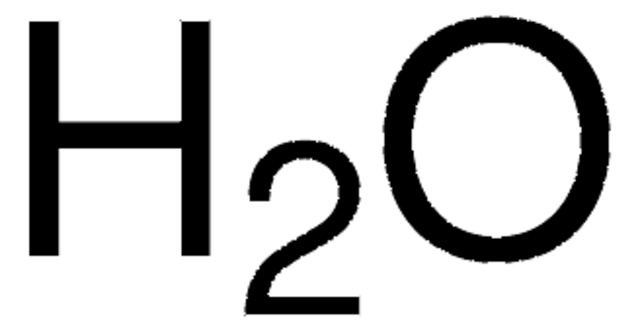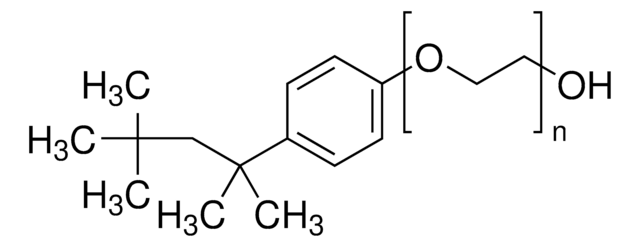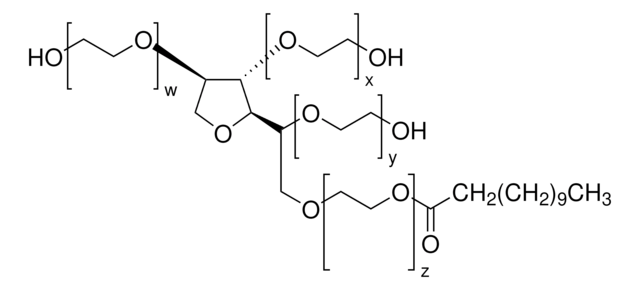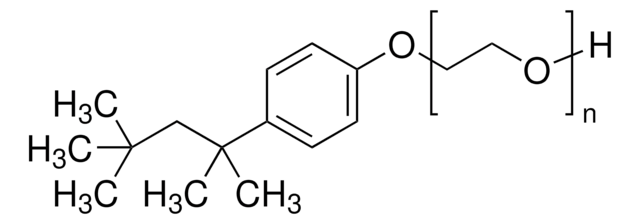推荐产品
表单
solid
浓度
≥50.0% (degree of coupling)
溶解性
DMF: 1 mg/mL, clear
荧光
λex 510 nm; λem 514-534 nm in PBS, pH 7.4
储存温度
−20°C
一般描述
Abberior STAR 488是STED显微镜的最新发展。它是一种非常明亮的绿色荧光染料,可以在主要的488 nm激光波长上非常有效地被激发。Abberior STAR 488可以替代Oregon绿488、Atto™ 488或Alexa Fluor 488等染料。
STED:在STED显微镜中可在585-605 nm处最有效地耗尽染料。
Abberior STAR 488是可在488 nm处激发的染料。并且,该染料专门设计和测试与我们的STAR 440Sx(在590 nm处激发)进行联合使用,用于双色STED显微镜中。该染料已在Leica 双色TCS STED CW显微镜中成功测试。
关键特性
最大吸收波长,λmax: 503 nm (PBS, pH 7.4)
消光系数,ε(λmax): 65′000 M-1cm-1 (PBS, pH 7.4)
校正系数,CF260 = ε260/εmax: 0.28 (PBS, pH 7.4)
校正系数 CF280 = ε280/εmax: 0.14 (PBS, pH 7.4)
荧光最大值,λfl: 524nm (PBS, pH 7.4)
推荐的STED波长,λSTED: 585 - 605 nm
荧光量子产率,η: 0.89 (PBS, pH 7.4)
荧光寿命,τ: 3.9 ns (MeOH)
STED:在STED显微镜中可在585-605 nm处最有效地耗尽染料。
Abberior STAR 488是可在488 nm处激发的染料。并且,该染料专门设计和测试与我们的STAR 440Sx(在590 nm处激发)进行联合使用,用于双色STED显微镜中。该染料已在Leica 双色TCS STED CW显微镜中成功测试。
关键特性
- 可在488 nm激发的STED染料
- 在STED显微镜中的理想耗尽行为(〜590 nm)
- STAR 440SX的双色标记组合,可用于双色STED显微镜
最大吸收波长,λmax: 503 nm (PBS, pH 7.4)
消光系数,ε(λmax): 65′000 M-1cm-1 (PBS, pH 7.4)
校正系数,CF260 = ε260/εmax: 0.28 (PBS, pH 7.4)
校正系数 CF280 = ε280/εmax: 0.14 (PBS, pH 7.4)
荧光最大值,λfl: 524nm (PBS, pH 7.4)
推荐的STED波长,λSTED: 585 - 605 nm
荧光量子产率,η: 0.89 (PBS, pH 7.4)
荧光寿命,τ: 3.9 ns (MeOH)
应用
抗兔IgG抗体® STAR 488抗体已作为二抗用于:
- 在前列腺癌细胞系PPC-1和TSU-Pr1中进行荧光免疫组化分析
- 用于HeLa和猴肾COS-7细胞的免疫荧光中
- OLN-t40-α-syn细胞(少突胶质细胞)中的STED(刺激发射损耗)显微镜分析
适用性
设计和测试用于荧光超分辨率显微镜
其他说明
法律信息
Atto is a trademark of Atto-Tec GmbH
abberior is a registered trademark of Abberior GmbH
储存分类代码
11 - Combustible Solids
WGK
WGK 3
闪点(°F)
Not applicable
闪点(°C)
Not applicable
Giuseppe Vicidomini et al.
Methods (San Diego, Calif.), 66(2), 124-130 (2013-07-03)
Stimulation emission depletion (STED) microscopy breaks the spatial resolution limit of conventional light microscopy while retaining its major advantages, such as working under physiological conditions. These properties make STED microscopy a perfect tool for investigating dynamic sub-cellular processes in living
Katharina Pukaß et al.
Frontiers in cellular neuroscience, 9, 163-163 (2015-05-23)
α-Synuclein (α-syn) positive glial cytoplasmic inclusions (GCI) originating in oligodendrocytes (ODC) are a characteristic hallmark in multiple system atrophy (MSA). Their occurrence may be linked to a failure of the ubiquitin proteasome system (UPS) or the autophagic pathway. For proteasomal
Combination of axitinib and dasatinib for anti-cancer activities in two prostate cancer cell lines.
Peng N
Bangladesh Journal of Pharmacology, 11, 10-10 (2016)
S W Hell et al.
Optics letters, 19(11), 780-782 (1994-06-01)
We propose a new type of scanning fluorescence microscope capable of resolving 35 nm in the far field. We overcome the diffraction resolution limit by employing stimulated emission to inhibit the fluorescence process in the outer regions of the excitation
Marcus Dyba et al.
Nature biotechnology, 21(11), 1303-1304 (2003-10-21)
We report immunofluorescence imaging with a spatial resolution well beyond the diffraction limit. An axial resolution of approximately 50 nm, corresponding to 1/16 of the irradiation wavelength of 793 nm, is achieved by stimulated emission depletion through opposing lenses. We
我们的科学家团队拥有各种研究领域经验,包括生命科学、材料科学、化学合成、色谱、分析及许多其他领域.
联系技术服务部门




